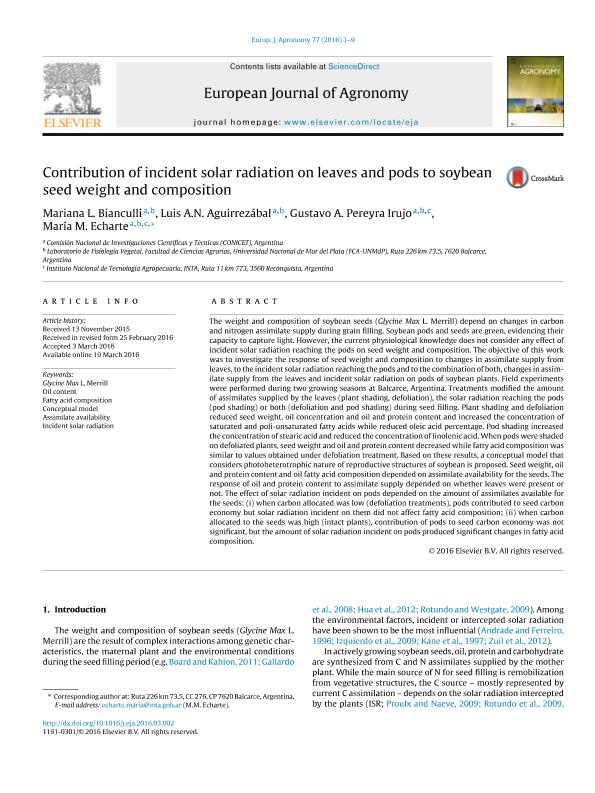Artículo
Contribution of incident solar radiation on leaves and pods to soybean seed weight and composition
Bianculli, Mariana Lujan ; Aguirrezábal, Luis Adolfo Nazareno
; Aguirrezábal, Luis Adolfo Nazareno ; Pereyra Irujo, Gustavo Adrian
; Pereyra Irujo, Gustavo Adrian ; Echarte, Maria Mercedes
; Echarte, Maria Mercedes
 ; Aguirrezábal, Luis Adolfo Nazareno
; Aguirrezábal, Luis Adolfo Nazareno ; Pereyra Irujo, Gustavo Adrian
; Pereyra Irujo, Gustavo Adrian ; Echarte, Maria Mercedes
; Echarte, Maria Mercedes
Fecha de publicación:
07/2016
Editorial:
Elsevier Science
Revista:
European Journal of Agronomy
ISSN:
1161-0301
Idioma:
Inglés
Tipo de recurso:
Artículo publicado
Clasificación temática:
Resumen
The weight and composition of soybean seeds (Glycine Max L. Merrill) depend on changes in carbon and nitrogen assimilate supply during grain filling. Soybean pods and seeds are green, evidencing their capacity to capture light. However, the current physiological knowledge does not consider any effect of incident solar radiation reaching the pods on seed weight and composition. The objective of this work was to investigate the response of seed weight and composition to changes in assimilate supply from leaves, to the incident solar radiation reaching the pods and to the combination of both, changes in assimilate supply from the leaves and incident solar radiation on pods of soybean plants. Field experiments were performed during two growing seasons at Balcarce, Argentina. Treatments modified the amount of assimilates supplied by the leaves (plant shading, defoliation), the solar radiation reaching the pods (pod shading) or both (defoliation and pod shading) during seed filling. Plant shading and defoliation reduced seed weight, oil concentration and oil and protein content and increased the concentration of saturated and poli-unsaturated fatty acids while reduced oleic acid percentage. Pod shading increased the concentration of stearic acid and reduced the concentration of linolenic acid. When pods were shaded on defoliated plants, seed weight and oil and protein content decreased while fatty acid composition was similar to values obtained under defoliation treatment. Based on these results, a conceptual model that considers photoheterotrophic nature of reproductive structures of soybean is proposed. Seed weight, oil and protein content and oil fatty acid composition depended on assimilate availability for the seeds. The response of oil and protein content to assimilate supply depended on whether leaves were present or not. The effect of solar radiation incident on pods depended on the amount of assimilates available for the seeds: (i) when carbon allocated was low (defoliation treatments), pods contributed to seed carbon economy but solar radiation incident on them did not affect fatty acid composition; (ii) when carbon allocated to the seeds was high (intact plants), contribution of pods to seed carbon economy was not significant, but the amount of solar radiation incident on pods produced significant changes in fatty acid composition.
Archivos asociados
Licencia
Identificadores
Colecciones
Articulos(CCT - MAR DEL PLATA)
Articulos de CTRO.CIENTIFICO TECNOL.CONICET - MAR DEL PLATA
Articulos de CTRO.CIENTIFICO TECNOL.CONICET - MAR DEL PLATA
Citación
Bianculli, Mariana Lujan; Aguirrezábal, Luis Adolfo Nazareno; Pereyra Irujo, Gustavo Adrian; Echarte, Maria Mercedes; Contribution of incident solar radiation on leaves and pods to soybean seed weight and composition; Elsevier Science; European Journal of Agronomy; 77; 7-2016; 1-9
Compartir
Altmétricas



